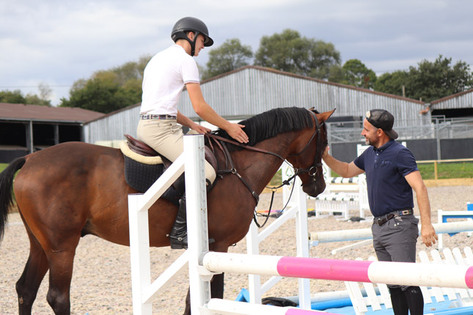
Are You & Your Horse Ready For Bitting Advice? The Steps You Need To Consider First
Equestrian Advice & Guides All Disciplines
Build your business profile for FREE and expose your services to thousands of potential clients!
Create my profile now!
Elliott Rowe is a successful international showjumper based at Rowebuck Stud in East Sussex, where he has been producing show jumpers for more than 20 years. Elliott has a wealth of knowledge and experience when it comes to producing horses and has shared some of his own insights to help others find their own successes. Here you can find tips on the process, right from sourcing your own horse through to moving up the levels.

Choosing Your Horse
Elliott recommends sourcing horses from Holland, Belgium, Germany and the UK. The reason behind this is due to the incredibly strict requirements that the horses in these countries are required to meet, before being allowed to go to stud. This has enabled these top breeding countries to really stay on top of their game and produce quality not quantity. “When buying young horses, it is just as important to look into the history of the mare as it is the stallion. An exceptional stallion and an average mare are unlikely to produce a world beater. The mare needs to have a history of good breeding also” explains Elliott.
If you are assessing something through loose jumping, then there are some characteristics that you should look for which will help you determine if the horse in question may have the ability you are looking for. “Does the horse have a nice technique? Does it demonstrate scope? Does it look like it’s enjoying it? Is it relaxed and showing intelligence? Is it meeting the fence on a nice stride? How does it take off and land?” lists Elliott. “These are all vital components that need to be considered. If the horse doesn’t loose school well, then the chances are it won’t be the best under saddle either. Look for something that has a nice head and eye, good confirmation and feet, and a character that wants to work with you. If you consider all of these factors, it will enable you to be selective for all the right reasons” explains Elliott.

Development
The starting process with an unbroken horse will be different to that of something a little older, however, patience at any age is imperative. Before Elliott does anything with an unbroken horse, he has their teeth checked to ensure they are perfectly happy in the mouth. Once this has been done, he will begin the long reining process which lasts up to 6 weeks. If they are fresh, they will be loose schooled to relax them and take the edge off, before being worked. He will then use an eggbutt snaffle with some bit butter to help keep their mouth nice and soft, and will take them around all of the onsite facilities such as the indoor arena, outdoor arena, and canter track, plus walking up the lane. This is to ensure they have seen everything they would do when under saddle.
Elliott explains how tension in the horse will make for an unpleasant training experience and how very important it is to mitigate this in order to get the best out of your horse. Elliott is very fortunate to have plenty of space and facilities on site, where he can work with his horses to ensure he gets the best out of them on their learning journey.

Once backed and working on the flat, Elliott emphasizes the importance of trotting and transitions in the early stages, and providing a variety of education. Elliott likes to use the canter track to work on getting a nice rhythm, but it also works wonders for two different types of horses. “With sharp horses, you can just trot them in a straight line and switch them off, and for the lazier horses, you can give them a bit of a gallop and get more blood in them,” says Elliott.

When you are ready to start working with poles, here are Elliott’s favourite training exercises:
Poles On The Floor
Put all the poles on the floor between the wings and ride the horse around the course and over the poles. You want your horse to relax, land on the right lead and not put too much effort into jumping over them. Once your horse is doing this nicely you can start to build the jumps up and introduce fillers.

“V” Poles And Straightening Poles
Elliott likes to train with both “v” poles and straightening poles on all fences. He places straightening poles before and after the jump to help keep them nice and straight and the “v” poles encourage them to use their shoulders. “You can get foam straightening poles, which are great for young horses in case they accidentally land on one” says Elliott.

The Clock
On a 20m circle place a pole at 12,3,6 and 9. For the more advanced horse this is a great technical exercise and can be made even more challenging for the rider if tackled without stirrups.

Poles Down The Longside And Bounces
For this you need to set poles at various distances down one side of your school and then ride through the poles in your horse's natural rhythm. Then you can practice adding strides and taking strides out.
Bounces help the horse to become quick in the front and the rider cannot help the horse out too much, encouraging them to think for themselves.

Pole, Cross Pole, Pole
Place a pole 3 strides away from a cross pole and then another 3 strides after and then trot in. Trotting this exercise is good for all ages of horses and amazing for relaxing sharper horses who like to rush into fences.
“Many people get into trouble jumping when they don’t have enough canter. Always ride with a big forward canter, even in a small school try to establish ring pace” explains Elliott.

Getting Out And About
When you are ready to start venturing out, Elliott suggests hiring various venues (especially places you may compete at in the future) so they have experienced somewhere new. Make sure when you arrive at the venue, they are relaxed as possible and then work on your exercises. The next step would be to attend a clear round show at one of these venues and practice riding a course.
Elliott says “It is important when preparing for your first show to ensure you don’t take your horse fresh. Give them a nice amount of work leading up to it and if you have time beforehand, give them a loose school or even a ride. You really don’t want to be in a rush so allow plenty of time. If they are a little green in the clear round, just take them round again. You want to encourage nice experiences, straightness and rhythm. You want to apply everything you have been practicing in training. Don’t jump too big in the warm up. The practice ring is to relax your horse and get them loose. You don’t want to knock their confidence in the warm up”.

“Remember why you are there and don’t worry about what other people think about you. Just concentrate on giving your horse the best experience you can. Once you and your horse are happy to move forward, you can then enter into British Novice and work up from here” explains Elliott.
Elliott works to 4 double clears and then moves his horses up, however points out that it is important to take the horse's age into consideration and recommends only moving up if you feel ready to do so and to stay back more than going too fast. If you push yourself and your horse enough at home, then jump smaller at a show, it will enable you to get the best out of your horse.
“So, buy right, be patient and produce them well,” states Elliott.

Like the facilities on show? Why not head over to rowebuckshowground.co.uk for the latest information on events and arena hire. Or better still, train with Elliott himself to maximise the potential of your horse and rider partnership! Enquire now via the Rowebuck Equestrian contact form.

